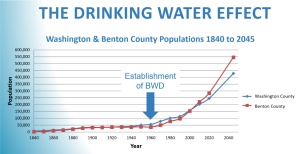
I have a slide that I routinely use in presentations about the history of Beaver Water District and Beaver Lake titled “The Drinking Water Effect”. The slide shows the combined population of Washington and Benton Counties from 1840 to present day, along with recent population projections out to 2040. From 1900 to 1960, the two-county population growth was fairly flat at just under 100,000 total people. Then, something happened. From 1960 to 2020, the populations of both counties have essentially doubled every 20 years. And… as we all know… that trend is projected to continue. By 2040-ish, we will likely exceed 1 million people. What was the trigger of our exceptional growth? The establishment of a clean, adequate source of water for all municipal and industrial purposes.

Northwest Arkansas (NWA) is like an eager teenager going through a growth spurt. It’s bustling with energy, attracting new residents, businesses, and opportunities. As of 2024, NWA remains the fastest-growing metro in Arkansas, and Benton County leads the state’s growth. NWA is aiming for the big leagues, and it’s doing so with gusto. This growth isn’t just about numbers; it’s about transforming the landscape, economy, and lifestyle of the region. This surge in population has significant implications for both drinking water demands and water quality in the region. Let’s dive into this topic and explore how the rapid expansion is impacting Beaver Lake—the primary source of drinking water for Northwest Arkansas (and beyond).
Beaver Lake: The Lifeline
Nestled in the picturesque Ozark Mountains, Beaver Lake isn’t just a scenic gem; it’s the beating heart of NWA’s water supply. This reservoir, formed by the White River, receives water from several tributaries, including War Eagle Creek and Richland Creek. Its significance? Beaver Lake provides drinking water to over 500,000 customers in the region. From Oklahoma to Harrison, and from Missouri to Mountainburg, Beaver Lake serves one out of every five Arkansans!
The Challenge: Balancing Growth and Water Needs
As NWA grows, so do its water demands. New homes, businesses, and industries require more water. Beaver Lake must keep up. But here’s the catch, Beaver Lake’s water quantity isn’t infinite. It’s a finite resource, and we need to manage it wisely. The delicate balance lies in meeting the needs of a burgeoning population while safeguarding the lake’s health.
Water Quality Matters
First, the good news: Beaver Lake enjoys generally good water quality. However, this doesn’t mean we can rest easy. Long-term monitoring continues to reveal trends that matter. Beaver Water District and many partner organizations like H2Ozarks, Beaver Watershed Alliance, and the Arkansas Water Resources Center (AWRC) regularly collect water samples throughout the Beaver Lake watershed to monitor water quality trends. AWRC has collected water samples from sites in the Upper White River Basin and the Upper Illinois River Watershed. These samples undergo testing for nutrients, sediments, chloride, sulfate, and more. The results? Water quality is improving at most sites, thanks to better wastewater treatment processes and nutrient management policies in the Illinois River watershed.
But—yes, there’s a “but”—some parameters show worsening trends within the Beaver lake watershed. Nitrogen concentrations in the White River and War Eagle Creek are decreasing, while phosphorus remains stable. Richland Creek’s phosphorus situation is improving, but nitrogen levels are rising. According to the Arkansas Natural Resources Division’s (ANRD) Nutrient Reduction Strategy dashboard, the overall levels of nitrogen and phosphorus across the Beaver watershed have increased. These changes matter because they impact the lake’s overall health.
The Way Forward – Collaboration and Stewardship
To secure Beaver Lake’s future, collaboration is key. Here’s what we can do:
1. Smart Growth Planning:
As NWA expands, let’s plan smartly. Consider water infrastructure—those pipes and lines that connect us to the system. Infill growth should align with the capacity of our water and sewer systems.
2. Education and Outreach:
We have to continue to educate residents about water conservation. Every drop counts, especially when it comes from Beaver Lake.
3. Monitoring and Adaptation:
We must continue and even expand monitoring water quality. Adapt growth policies based on data. Celebrate success stories and address challenges.
Remember, Beaver Lake isn’t just a reservoir; it’s our lifeline. As NWA thrives, let’s ensure that our growth doesn’t compromise the very water that sustains us. Continued growth and development will ensure the region’s continued vitality that we all benefit from, but it’s a double-edged sword that can cut both ways. We must use our water wisely and protect our greatest natural resource, Beaver Lake, for the generations to follow!
So, if you ever find yourself strolling along its shores, take a moment to appreciate the beauty and the responsibility we share in preserving it.
